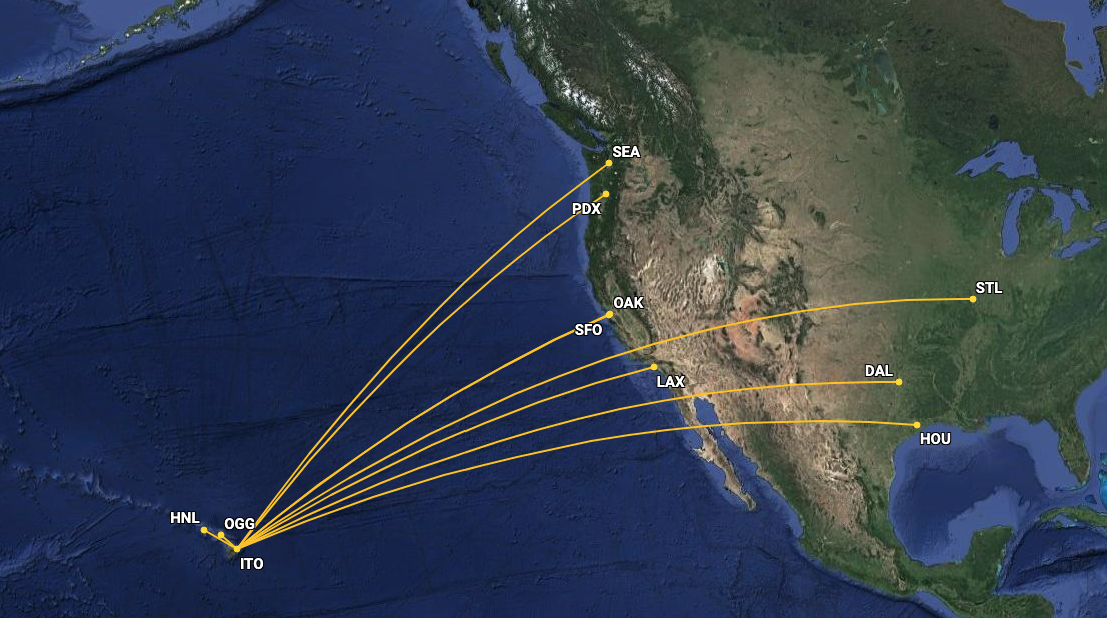The Hilo Airport Is Criminally Underutilized. Bringing Back Mainland Routes Would Ease Travel Burdens On Most Big Island Residents.
Citing routine schedule changes and low demand, United Airlines discontinued its nonstop service from Hilo to Los Angeles in 2023. This left the Hilo International Airport, despite its name, without a flight to the mainland for the first time in more than a decade.
The nonstop redeye to LAX had existed since 2011, with a brief hiatus during the height of the COVID-19 pandemic. Unfortunately, it doesn’t appear that any other airline is willing to fill this void just yet.
When you consider that most Big Island residents live closer to the Hilo Airport than they do to the route-abundant one in Kona, casting ITO aside doesn’t make a whole lot of sense.
Despite a statewide population decline, the Puna district on the Big Island is actually increasing in population, thanks to being one of the last affordable housing markets in the entire state. Hawaiian Paradise Park, one of the largest unincorporated subdivisions in America, is only about a 20-minute drive from ITO.
From the Kona International Airport at Keahole, door-to-door travel time is almost two hours, and that’s assuming no traffic or inclement weather on Saddle Road, the highway that straddles the narrow gap between Mauna Kea and Mauna Loa, often plagued by thick fog and heavy rain throughout the year that can delay travel times even further.
As of right now, residents of east Hawaii have two choices to get to the mainland: make the two-hour drive to Kona and catch a flight there, or depart from Hilo and fly to Maui or Honolulu to make connections.
So if demand is anticipated to increase, why aren’t any airlines taking advantage of an underserved airport that could benefit not only residents and tourists alike but also the airlines themselves?
The Hilo Airport has managed to perpetually struggle since the 1980s. Prior to 1979, several airlines offered long-haul routes from the airport to mainland coastal cities like San Francisco, Seattle, Portland, and Los Angeles, in addition to locations east of the Continental Divide such as Dallas Love Field, Houston, and St. Louis.
But as tourism shifted to the drier, sunnier leeward side of the Big Island, airlines lost interest in keeping their Hilo routes alive, leaving ITO with no mainland flights for 20 years.
ATA Airlines briefly offered service from Hilo to Oakland in 2006 before going out of business, and United came back to Hilo once again in 2011, offering nonstop service to San Francisco and LAX. The SFO route didn’t last long, being removed from United’s schedule only two years later.
Just as there are plenty of drawbacks to living in a popular tourist destination such as traffic jams and crowded beaches during peak seasons, there are also several benefits, one of which is having access to numerous travel options that otherwise wouldn’t be available based on population alone. To put things in perspective, the entire island of Hawaii has fewer residents than the city of Lubbock, Texas. For comparison, Lubbock’s airport has only eight nonstop routes; Kona’s airport has 21, including seasonal flights to both major Tokyo airports.
Without volcanoes, waterfalls, national landmarks, and spectacular views, it’s likely that mainland flights to the Big Island would all but disappear. So it is, at least at face value, more economically efficient for airlines to focus their attention on the Kona Airport, located closer to the concentration of popular resorts on the island. Although the majority of hotel accommodations on the Big Island are on the Kona side, the Hilo Airport does have the advantage of a shorter distance to Hawaii Volcanoes National Park, Akaka Falls, and Punalu’u Beach, signaling that the potential for the airport is not completely lost.
As travel increases during the summer months and ticket prices into Kona mirror the rising demand, airlines could take advantage of the Hilo Airport’s underutilization by enticing potential travelers from the mainland with lower fares and thereby stiffening competition between carriers, be it from Las Vegas, San Jose, Phoenix, or Los Angeles, all cities of which have nonstop routes to Kona already.
While there is no expectation of ITO turning into an international hub, a handful of flights to the mainland would be beneficial for both the airlines and the residents who call the Big Island home.
The infrastructure at ITO is more than capable of handling additional flights. It’s only a matter of convincing the airlines to reconsider how they see a small, but highly valuable market with lots of potential that’s often overlooked.
– HawaiiLocal.News

